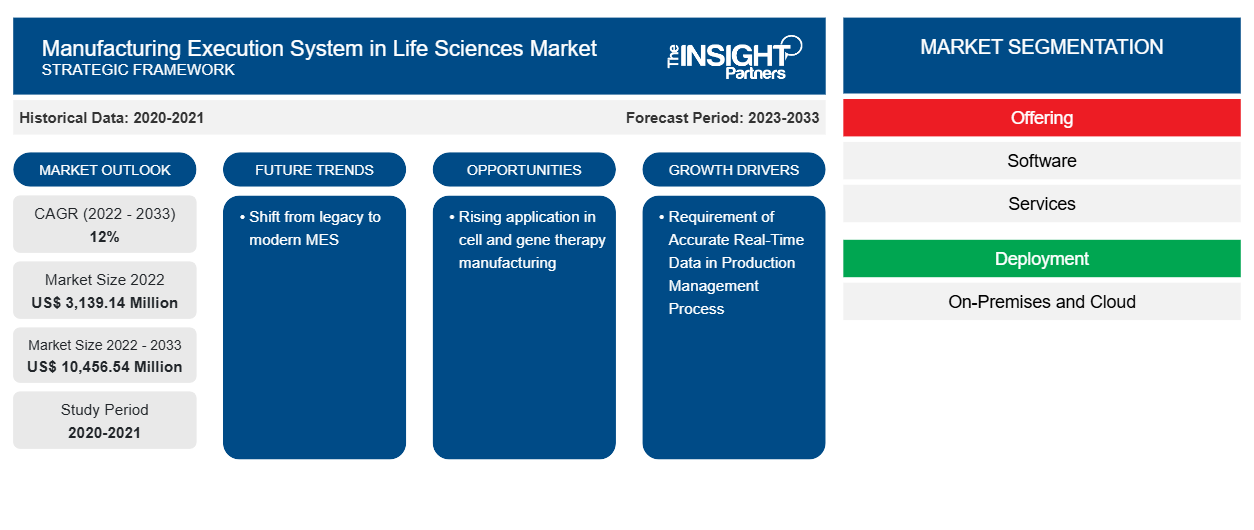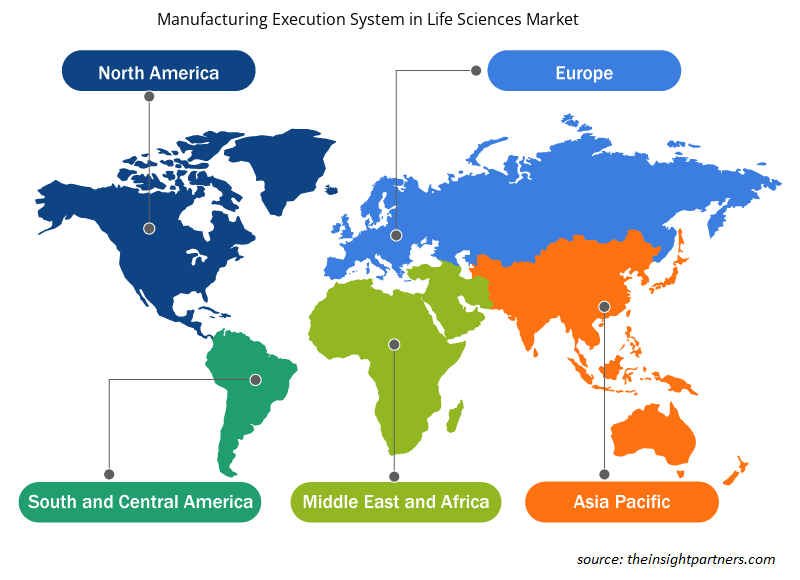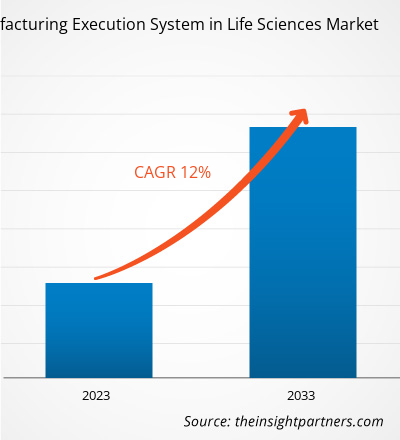Se proyecta que el tamaño del mercado de sistemas de ejecución de fabricación en ciencias biológicas alcance los 10 456,54 millones de dólares estadounidenses en 2033, frente a los 3139,14 millones de dólares estadounidenses en 2022. Se espera que el mercado registre una CAGR del 12 % durante el período 2023-2033. Es probable que el cambio de un sistema MES tradicional a uno moderno siga siendo una tendencia clave en el mercado.
Análisis del mercado de sistemas de ejecución de fabricación en las ciencias de la vida
Las soluciones MES modernas están incorporando más aspectos de las plataformas de planificación de recursos empresariales (ERP). Esto les permite ofrecer un mejor seguimiento logístico, identificación de materiales e integración con las operaciones de producción, junto con un modelo distribuido que supera la producción tradicional. Además, las soluciones MES tradicionales se centran en la fabricación por lotes y, a menudo, no son capaces de ofrecer las capacidades necesarias sin una personalización significativa. En el período de pronóstico, se espera que estos factores promuevan la adopción de sistemas de ejecución de fabricación modernos entre los investigadores de las ciencias de la vida.
Descripción general del mercado de sistemas de ejecución de fabricación en ciencias biológicas
El sistema de ejecución de fabricación (MES) es una solución dinámica e integral que ayuda a rastrear, documentar, monitorear y controlar el proceso de fabricación de bienes, desde las materias primas hasta los productos terminados. Estas soluciones también proporcionan a los tomadores de decisiones datos multivariados que se pueden utilizar para optimizar las operaciones de la planta y mejorar la eficiencia de la producción. El MES puede tener funcionalidades extendidas, generalmente denominadas funciones de gestión de operaciones de fabricación (MOM). El término "gestión de operaciones de fabricación" se define como el Nivel 3 de la norma ANSI/ISA-95 Enterprise-Control System Integration.
Personalice este informe según sus necesidades
Obtendrá personalización en cualquier informe, sin cargo, incluidas partes de este informe o análisis a nivel de país, paquete de datos de Excel, así como también grandes ofertas y descuentos para empresas emergentes y universidades.
Sistema de ejecución de fabricación en el mercado de las ciencias biológicas: perspectivas estratégicas

-
Obtenga las principales tendencias clave del mercado de este informe.Esta muestra GRATUITA incluirá análisis de datos, desde tendencias del mercado hasta estimaciones y pronósticos.
Impulsores y oportunidades del mercado de sistemas de ejecución de fabricación en ciencias biológicas
Necesidad de disponer de datos precisos en tiempo real en el proceso de gestión de la producción
MES puede ayudar a los fabricantes a funcionar con una fuerza laboral menor, recopilar datos precisos en tiempo real del proceso de producción, aumentar la eficiencia y la flexibilidad del proceso, salvaguardar las expectativas regulatorias y digitalizar el proceso de fabricación.
En febrero de 2022, Integer anunció que había adquirido el sistema de ejecución de fabricación (MES) de Critical Manufacturing para mejorar la eficiencia y la calidad de sus procesos de producción globales. La empresa utilizará este módulo en su planta de Irlanda para digitalizar sus procesos de producción, recopilar datos en tiempo real y mejorar la eficiencia, la calidad y la trazabilidad. De manera similar, en septiembre de 2020, Körber y Walvax Biotechnology anunciaron que habían firmado un acuerdo para implementar Werum PAS-X MES, el MES para la fabricación de productos farmacéuticos, biotecnológicos y de terapia celular y genética, en su planta de Yuxi para la producción de vacunas. Según Körber, PAS-X MES permite al usuario gestionar, visualizar y analizar datos de forma rápida, completa y en tiempo real. En agosto de 2019, Takeda Ireland Ltd. implementó PAS-X MES en un enfoque por fases en su planta de producción de Grange Castle, Irlanda, y la transformó en una fábrica sin papel. Esta creciente adopción de MES por parte de los actores del mercado para recopilar datos precisos en tiempo real en el proceso de gestión de la producción está impulsando el crecimiento de los sistemas de ejecución de fabricación en el mercado de las ciencias de la vida. Además, las soluciones MES modernas (a menudo denominadas MES ligero) son muy flexibles, se adaptan a los requisitos, integran varias herramientas y están basadas en la nube . Además, los MES y los sistemas de ejecución de laboratorio (LES) también pueden ayudar a reducir el riesgo de contaminación, mejorar la integridad de los datos, reducir los costos operativos, garantizar el cumplimiento normativo y la calidad, y mejorar las capacidades de seguimiento y rastreo. Debido a todas las ventajas anteriores del uso de MES, varios actores del mercado están adoptando el sistema.
Aplicación creciente en la fabricación de terapias celulares y genéticas
También hay un número cada vez mayor de colaboraciones entre los principales proveedores de soluciones del ecosistema de la industria farmacéutica para desarrollar soluciones avanzadas para la fabricación de productos de terapia celular y genética. En enero de 2022, TrakCe colaboró con Korber para la integración de software. La colaboración dio como resultado una integración funcional entre OCELLOS de TrakCel y PAS-X de Körber. Se espera que permita a los clientes de terapia celular y genética de ambas empresas compartir de manera eficaz datos que detallen eventos e hitos de fabricación, como controles de inicio, llenado y acabado, y lanzamiento de productos; y proporcionar registros de auditoría y trazabilidad completos. En octubre de 2021, Körber y Vineti anunciaron que se asociarían para integrar PAS-X MES de Korber con la plataforma de gestión de terapia personalizada (PTM) líder en la industria de Vineti. Esta asociación empoderará aún más a los clientes biofarmacéuticos con una solución PAS-X MES integrada, que ayudará a llevar terapias celulares y genéticas que salvan vidas a los pacientes que las necesitan. Por lo tanto, se espera que la creciente aplicación y adopción de MES por parte de los actores del mercado en la fabricación de terapias celulares y genéticas cree una oportunidad para el crecimiento del sistema de ejecución de fabricación en el mercado de las ciencias biológicas durante el período de pronóstico.
Análisis de segmentación del informe de mercado del sistema de ejecución de fabricación en las ciencias biológicas
Los segmentos clave que contribuyeron a la derivación del sistema de ejecución de fabricación en el análisis del mercado de las ciencias de la vida son la oferta, la implementación, el tamaño de la organización y la aplicación.
- Según la oferta, el sistema de ejecución de fabricación en el mercado de las ciencias de la vida se divide en hardware y software. El segmento de software tuvo una mayor participación de mercado en 2023.
- Por implementación, el mercado se segmenta en local y en la nube.
- Por tamaño de organización, el mercado está segmentado en PYMES y grandes empresas.
- Por aplicación, el mercado está segmentado en productos farmacéuticos, biotecnológicos y dispositivos médicos.
Análisis de la cuota de mercado del sistema de ejecución de fabricación en las ciencias biológicas por geografía
El alcance geográfico del informe de mercado del sistema de ejecución de fabricación en las ciencias de la vida se divide principalmente en cinco regiones: América del Norte, Asia Pacífico, Europa, Oriente Medio y África, y América del Sur y Central. En América del Norte, se proyecta que las innovaciones tecnológicas ofrecerán oportunidades de crecimiento para el sistema de ejecución de fabricación en el mercado de las ciencias de la vida. Además, la creciente digitalización de los procesos de fabricación en la industria farmacéutica está impulsando el crecimiento del sistema de ejecución de fabricación en el mercado de las ciencias de la vida en la región. Además, la presencia de actores del mercado como Apprentice FS, Inc; Atachi Systems; Emerson Electric Co; POMS Corporation; y Rockwell Automation, que trabajan continuamente para facilitar los procesos de fabricación en la industria de la salud, está impulsando el crecimiento del sistema de ejecución de fabricación en el mercado de las ciencias de la vida.
Perspectivas regionales del mercado de sistemas de ejecución de fabricación en ciencias biológicas
Los analistas de Insight Partners explicaron en detalle las tendencias y los factores regionales que influyen en el mercado de sistemas de ejecución de fabricación en ciencias biológicas durante el período de pronóstico. Esta sección también analiza los segmentos y la geografía del mercado de sistemas de ejecución de fabricación en ciencias biológicas en América del Norte, Europa, Asia Pacífico, Oriente Medio y África, y América del Sur y Central.

- Obtenga datos regionales específicos para el mercado de sistemas de ejecución de fabricación en ciencias biológicas
Alcance del informe de mercado del sistema de ejecución de fabricación en las ciencias biológicas
| Atributo del informe | Detalles |
|---|---|
| Tamaño del mercado en 2022 | US$ 3.139,14 millones |
| Tamaño del mercado en 2033 | US$ 10.456,54 millones |
| CAGR global (2022-2033) | 12% |
| Datos históricos | 2020-2021 |
| Período de pronóstico | 2023-2033 |
| Segmentos cubiertos |
Al ofrecer
|
| Regiones y países cubiertos |
América del norte
|
| Líderes del mercado y perfiles de empresas clave |
|
Densidad de actores del mercado de sistemas de ejecución de fabricación en ciencias biológicas: comprensión de su impacto en la dinámica empresarial
El mercado de sistemas de ejecución de fabricación en las ciencias biológicas está creciendo rápidamente, impulsado por la creciente demanda de los usuarios finales debido a factores como la evolución de las preferencias de los consumidores, los avances tecnológicos y una mayor conciencia de los beneficios del producto. A medida que aumenta la demanda, las empresas amplían sus ofertas, innovan para satisfacer las necesidades de los consumidores y aprovechan las tendencias emergentes, lo que impulsa aún más el crecimiento del mercado.
La densidad de actores del mercado se refiere a la distribución de las empresas o firmas que operan dentro de un mercado o industria en particular. Indica cuántos competidores (actores del mercado) están presentes en un espacio de mercado determinado en relación con su tamaño o valor total de mercado.
Las principales empresas que operan en el mercado de sistemas de ejecución de fabricación en ciencias biológicas son:
- Siemens AG
- Emerson Eléctrico
- Schneider Electric
- Automatización Rockwell
- Aprendiz FS Inc
- ATS Global
Descargo de responsabilidad : Las empresas enumeradas anteriormente no están clasificadas en ningún orden particular.

- Obtenga una descripción general de los principales actores clave del sistema de ejecución de fabricación en el mercado de ciencias biológicas
Noticias y desarrollos recientes del mercado de sistemas de ejecución de fabricación en ciencias biológicas
El sistema de ejecución de la fabricación en el mercado de las ciencias biológicas se evalúa mediante la recopilación de datos cualitativos y cuantitativos posteriores a la investigación primaria y secundaria, que incluye publicaciones corporativas importantes, datos de asociaciones y bases de datos. A continuación, se enumeran algunos de los avances en el sistema de ejecución de la fabricación en el mercado de las ciencias biológicas:
- Lonza y NNIT anunciaron una asociación para acelerar los proyectos MES. Las empresas colaborarán en la plataforma MODA de Lonza con la metodología de implementación acelerada de NNIT. (Fuente: Lonza, comunicado de prensa, marzo de 2021).
- AVEVA, líder mundial en software industrial que impulsa la transformación digital y la sostenibilidad, amplió CONNECT, su plataforma de inteligencia industrial líder en el mundo, con servicios de datos y visualización para soluciones híbridas de sistemas de ejecución de fabricación (MES). (Fuente: AVEVA, comunicado de prensa, abril de 2023)
Informe de mercado sobre sistemas de ejecución de fabricación en ciencias biológicas: cobertura y resultados
El informe “Tamaño y pronóstico del mercado de sistemas de ejecución de fabricación en ciencias biológicas (2023-2033)” proporciona un análisis detallado del mercado que cubre las siguientes áreas:
- Tamaño del mercado de sistemas de ejecución de fabricación en ciencias biológicas y pronóstico a nivel global, regional y nacional para todos los segmentos clave del mercado cubiertos por el alcance
- Tendencias del mercado de sistemas de ejecución de fabricación en ciencias biológicas, así como dinámicas del mercado, como impulsores, restricciones y oportunidades clave
- Análisis detallado de las cinco fuerzas de Porter y PEST y FODA
- Análisis del mercado de sistemas de ejecución de fabricación en ciencias biológicas que abarca las tendencias clave del mercado, el marco global y regional, los principales actores, las regulaciones y los desarrollos recientes del mercado
- Análisis del panorama de la industria y de la competencia que abarca la concentración del mercado, el análisis de mapas de calor, los actores destacados y los desarrollos recientes para el sistema de ejecución de fabricación en el mercado de las ciencias biológicas
- Perfiles detallados de empresas
- Análisis histórico (2 años), año base, pronóstico (7 años) con CAGR
- Análisis PEST y FODA
- Tamaño del mercado, valor/volumen: global, regional y nacional
- Industria y panorama competitivo
- Conjunto de datos de Excel
Informes recientes
Testimonios
Razón para comprar
- Toma de decisiones informada
- Comprensión de la dinámica del mercado
- Análisis competitivo
- Información sobre clientes
- Pronósticos del mercado
- Mitigación de riesgos
- Planificación estratégica
- Justificación de la inversión
- Identificación de mercados emergentes
- Mejora de las estrategias de marketing
- Impulso de la eficiencia operativa
- Alineación con las tendencias regulatorias






















 Obtenga una muestra gratuita para - Sistema de ejecución de fabricación en el mercado de las ciencias biológicas
Obtenga una muestra gratuita para - Sistema de ejecución de fabricación en el mercado de las ciencias biológicas